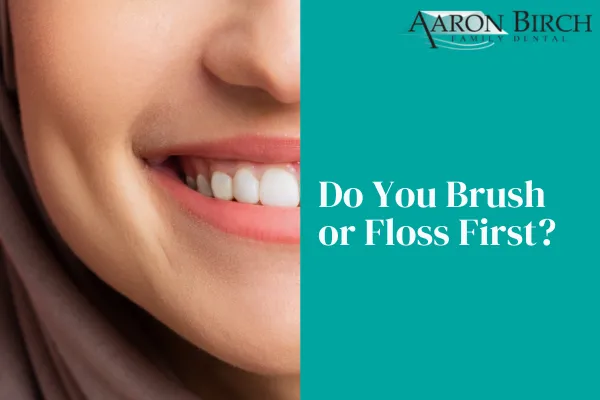
Floss or Brush First? Dr. Birch Weighs In
At Aaron Birch Family Dental, one of the most common questions we get from patients is: Should I floss before or after I brush my teeth? While both methods have their merits, the ultimate goal is the same—removing plaque and food particles to keep your mouth healthy. Let’s explore the reasoning behind each approach, and then we’ll share how Dr. Birch recommends you care for your teeth for the best results.
Why Some Professionals Recommend Brushing First
Brushing your teeth first is the traditional route for many people. Here’s why some dental professionals prefer it:
Fluoride boost: Brushing first coats your teeth with fluoride from your toothpaste, strengthening enamel and helping to prevent cavities.
Surface cleaning: Brushing removes plaque and debris from the surfaces of your teeth, which can make flossing feel more effective afterward.
Fresh feeling: For those who love that “just brushed” clean feeling, starting with a toothbrush seems like the best way to begin or end the day.
However, if you brush and don’t floss afterward, you might be leaving behind harmful particles and bacteria between your teeth that your toothbrush just can’t reach.
Why Others Recommend Flossing First
On the other hand, flossing before brushing is becoming increasingly popular among dentists and hygienists. Here’s why:
Cleaner brush reach: Flossing first dislodges plaque and food particles between teeth, allowing your toothbrush and toothpaste to access those areas more effectively.
Better fluoride coverage: Once your interdental spaces are cleared, fluoride from toothpaste can penetrate more deeply.
More complete cleaning: Studies suggest people who floss before brushing tend to remove more plaque than those who floss afterward.
You won’t forget to floss: Let’s be honest—many people brush and then forget or skip the floss. Putting flossing first can help build better habits.
Dr. Birch’s Recommended Routine: Brush, Floss, Then Use a Waterpik
While both floss-first and brush-first arguments have merit, Dr. Birch recommends a three-step approach for optimal oral hygiene:
Brush thoroughly for two minutes, twice a day, using a soft-bristled toothbrush and fluoride toothpaste.
Floss gently between every tooth to remove plaque and food particles your toothbrush can’t reach.
Use a Waterpik to flush out debris and bacteria from hard-to-reach places, including under the gumline and around dental work like bridges or implants.
This comprehensive approach helps ensure that your teeth and gums are as clean and healthy as possible.
Making Oral Health Easier for Patients
We understand that adding a Waterpik to your daily routine is an investment—which is why Dr. Birch offers Waterpiks at cost in our office. It’s not about selling gadgets; it’s about making advanced oral care more accessible for our patients.
A Waterpik can be especially helpful for:
Patients with braces or dental implants
Those who struggle with traditional floss
Anyone looking to elevate their hygiene routine
The Bottom Line
Whether you brush first or floss first, consistency is key. But if you want to take your dental care to the next level, follow Dr. Birch’s recommended routine: Brush, Floss, and then Waterpik.
Have questions or want to pick up a Waterpik at your next visit? Call us or ask at the front desk. Your healthiest smile starts with great daily habits—and we’re here to help every step of the way.


Facebook
Instagram